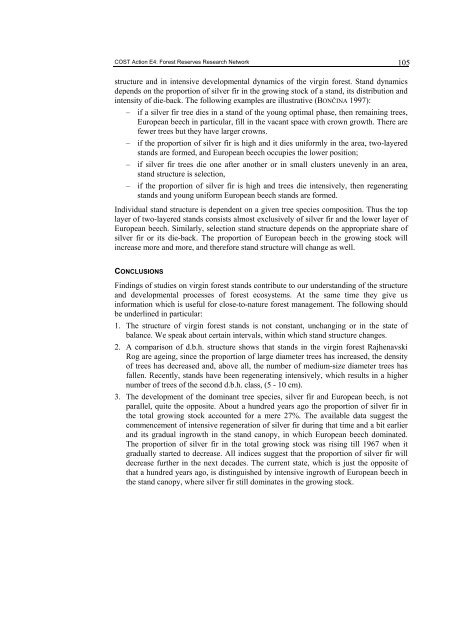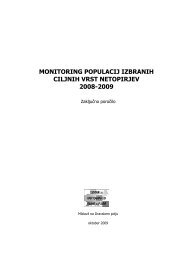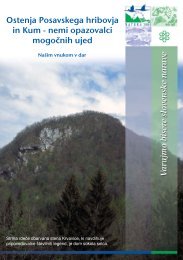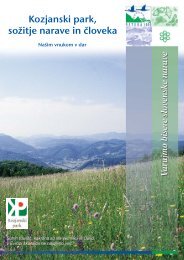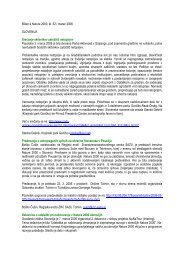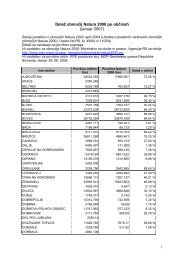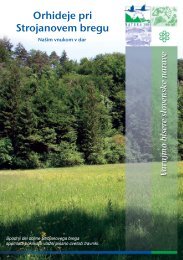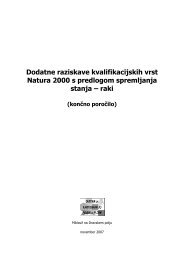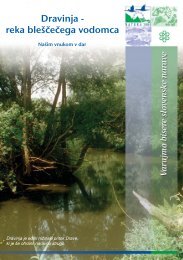VIRGIN FORESTS AND FOREST RESERVES IN ... - Natura 2000
VIRGIN FORESTS AND FOREST RESERVES IN ... - Natura 2000
VIRGIN FORESTS AND FOREST RESERVES IN ... - Natura 2000
Create successful ePaper yourself
Turn your PDF publications into a flip-book with our unique Google optimized e-Paper software.
COST Action E4: Forest Reserves Research Network 105<br />
structure and in intensive developmental dynamics of the virgin forest. Stand dynamics<br />
depends on the proportion of silver fir in the growing stock of a stand, its distribution and<br />
intensity of die-back. The following examples are illustrative (BONČ<strong>IN</strong>A 1997):<br />
– if a silver fir tree dies in a stand of the young optimal phase, then remaining trees,<br />
European beech in particular, fill in the vacant space with crown growth. There are<br />
fewer trees but they have larger crowns.<br />
– if the proportion of silver fir is high and it dies uniformly in the area, two-layered<br />
stands are formed, and European beech occupies the lower position;<br />
– if silver fir trees die one after another or in small clusters unevenly in an area,<br />
stand structure is selection,<br />
– if the proportion of silver fir is high and trees die intensively, then regenerating<br />
stands and young uniform European beech stands are formed.<br />
Individual stand structure is dependent on a given tree species composition. Thus the top<br />
layer of two-layered stands consists almost exclusively of silver fir and the lower layer of<br />
European beech. Similarly, selection stand structure depends on the appropriate share of<br />
silver fir or its die-back. The proportion of European beech in the growing stock will<br />
increase more and more, and therefore stand structure will change as well.<br />
CONCLUSIONS<br />
Findings of studies on virgin forest stands contribute to our understanding of the structure<br />
and developmental processes of forest ecosystems. At the same time they give us<br />
information which is useful for close-to-nature forest management. The following should<br />
be underlined in particular:<br />
1. The structure of virgin forest stands is not constant, unchanging or in the state of<br />
balance. We speak about certain intervals, within which stand structure changes.<br />
2. A comparison of d.b.h. structure shows that stands in the virgin forest Rajhenavski<br />
Rog are ageing, since the proportion of large diameter trees has increased, the density<br />
of trees has decreased and, above all, the number of medium-size diameter trees has<br />
fallen. Recently, stands have been regenerating intensively, which results in a higher<br />
number of trees of the second d.b.h. class, (5 - 10 cm).<br />
3. The development of the dominant tree species, silver fir and European beech, is not<br />
parallel, quite the opposite. About a hundred years ago the proportion of silver fir in<br />
the total growing stock accounted for a mere 27%. The available data suggest the<br />
commencement of intensive regeneration of silver fir during that time and a bit earlier<br />
and its gradual ingrowth in the stand canopy, in which European beech dominated.<br />
The proportion of silver fir in the total growing stock was rising till 1967 when it<br />
gradually started to decrease. All indices suggest that the proportion of silver fir will<br />
decrease further in the next decades. The current state, which is just the opposite of<br />
that a hundred years ago, is distinguished by intensive ingrowth of European beech in<br />
the stand canopy, where silver fir still dominates in the growing stock.


